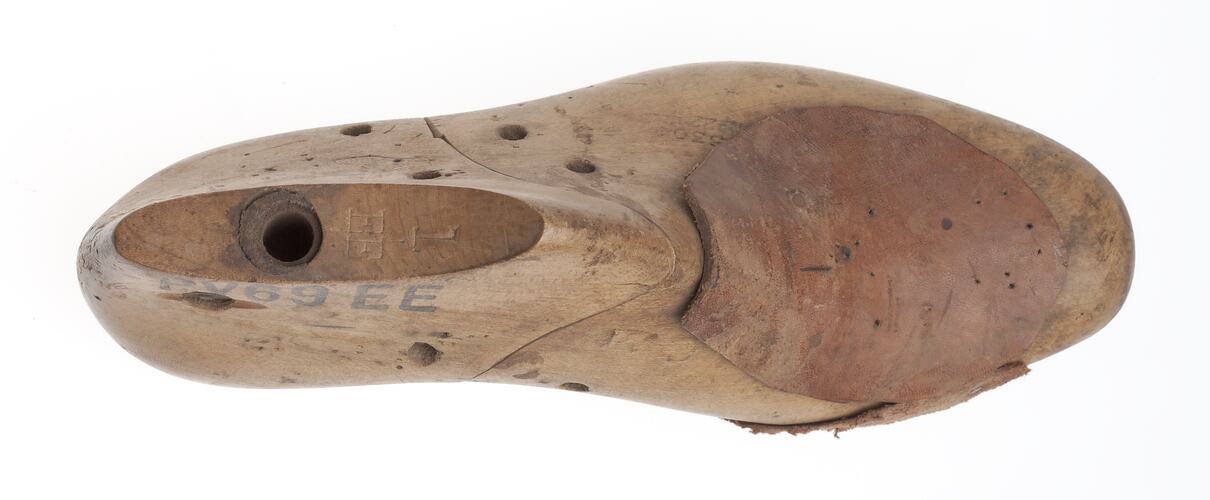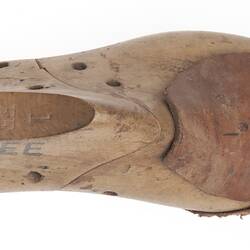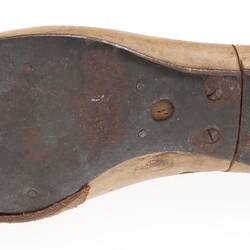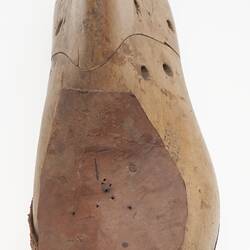Summary
This left foot solid timber shoe last is the form in which Stanio Fancoff's various shoes were moulded upon between the 1930s to 1970s. This shoe last allows the moulding of multiple shoes of the same heel height and toe shape. This particular shoe last's shape with its rounded toe, small foot and heel width suggest this object was an integral instrument used by Stanio in the making of his various womens' basketweave shoes.
Stanio Ivanoff Fancoff was born in 1908 in Bojentsi, a small village in Bulgaria. At age 11, Stanio left home to learn the shoemaking trade. In 1929, he immigrated to Melbourne, settled in Fitzroy and began to work for the V.G. Zemancheff & Sons basket shoe factory in South Melbourne. In1936, he married Dorotea Georgi Touzou who had recently arrived in Australia. Around this time, Stanio set up his own shoemaking business from home, with Georgi, her cousin and sister weaving the shoes which he then assembled. Select shoe samples were then taken to Sydney and Tasmania for sale. In 1942, Georgi and Stanio moved to Broken Hill for Georgi's health; there daughter Nancy was born and Stanio set up a shoe shop/factory. In 1945, Georgi died and by 1950 Stanio and Nancy had moved to Adelaide where he again opened a shoemaking business and shop. He passed away in 1978, having been in the shoemaking business for 59 years. This collection documents his migration and working life experiences.
Physical Description
Left foot solid wooden sculpted shoe last within a generic foot shape. Created from a solid light timber, the shoe last has eight puncture marks which appear to have metal placed within them and additional riverts run horizontally through the back top ankle area. Furthermore, at the top of the ankle section a hollow round hole exists in which a metal casing has been placed. The foot mould is constructed within two sections of forefoot and the back heel, whereby the visible join line runs from the vamp's top midway point to back of the arch. Throughout the shoe last several indentations and scratches are present, while located within the lower inner ankle/heel area a small crack runs vertically from the join line. Furthermore, two leather constructed patches adjoin the wooden mould's vamp and the inner flex point. While the vamp leather patch has two nails within its upper section and possibly glue to adhere its lower section, the inner flex leather patch is attached via three nails and has 2mm spaced scored vertical lines. Similar to the wooden shoe last, the metal sole has been created within a dual construct. The metal heel plate attaches via three screws (1back/2 front) and two nails attaching the metal sole plate to the wooden last, while the forefront including the arch has been affixed by three screws (2 back/1 front) and six nails systematically placed between screws. Furthermore, this forefront plate as two round holes allowing access to the wooden underneath sole.
Significance
This collection is significant in documenting a small migrant business as well as the fashion of a particular period. It is well provenanced and charts the application of trade skills in a new country. It also illustrates the stages of hand shoe manufacture from the 1930s, demonstrating the enduring nature of the tools and patterns that were used.
More Information
-
Collecting Areas
-
Acquisition Information
Donation from Nancy Vasileff, 21 Mar 2007
-
Past Owner or User
-
Inscriptions
Incised, inner top vamp: PV Stamped, black ink, inner top ankle: PV69EE Incised, outer ankle midway: Raymond (in the shape of a shoe) Stamped, black ink, outer side: RD. No 5304 / PATENT No 22276
-
Classification
-
Category
-
Discipline
-
Type of item
-
Overall Dimensions
75 mm (Width), 220 mm (Depth), 80 mm (Height)
-
References
R.A. Salaman, 'Dictionary of Leather-working Tools c.1700-1950 and Tools of Allied Trades,' London: George Allen and Unwin (Publishers) Ltd, 1986 [Section 2: Boot and Shoe Maker pp18-185]. John Peacock. 'Shoes, The Complete Sourcebook,' London:Thames & Hudson Ltd, 2005. NAA holds file (online) on Vasil George Zemancheff, Fancoff's employer
-
Keywords
Boot & Shoemaking, Bulgarian Communities, Bulgarian Immigration, Immigration, Small Businesses, Tools







